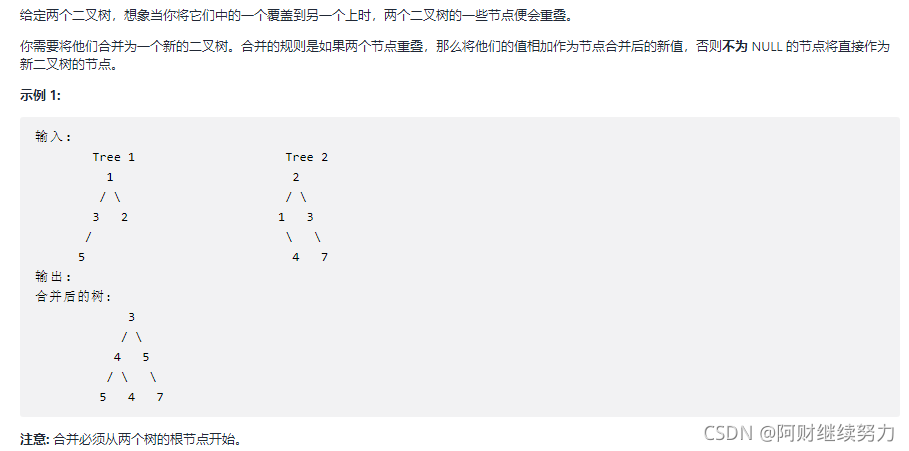1. 题目

2. 思路
(1) 递归
- 总体思想是新建一颗树。
- 当两棵树的根结点均不为null时,新建一个结点,值为两棵树的根结点的值之和;当任意一颗树的根结点为null时,返回另一颗树的根结点即可。
(2) 迭代
- 总体思想是将二叉树2合并到二叉树1上。
- 当两棵树的根结点均不为null时,全部入栈;当二叉树1的根结点为null,二叉树2的根结点不为null时,将二叉树2的根结点接到二叉树1上即可。
3. 代码
import java.util.Deque;
import java.util.LinkedList;
import java.util.Stack;
public class Test {
public static void main(String[] args) {
}
}
class TreeNode {
int val;
TreeNode left;
TreeNode right;
TreeNode() {
}
TreeNode(int val) {
this.val = val;
}
TreeNode(int val, TreeNode left, TreeNode right) {
this.val = val;
this.left = left;
this.right = right;
}
}
class Solution {
public TreeNode mergeTrees(TreeNode root1, TreeNode root2) {
if (root1 == null) {
return root2;
}
if (root2 == null) {
return root1;
}
TreeNode root = new TreeNode(root1.val + root2.val);
root.left = mergeTrees(root1.left, root2.left);
root.right = mergeTrees(root1.right, root2.right);
return root;
}
}
class Solution1 {
public TreeNode mergeTrees(TreeNode root1, TreeNode root2) {
if (root1 == null) {
return root2;
}
if (root2 == null) {
return root1;
}
Deque<TreeNode> stack = new LinkedList<>();
stack.push(root2);
stack.push(root1);
while (!stack.isEmpty()) {
TreeNode node1 = stack.pop();
TreeNode node2 = stack.pop();
node1.val += node2.val;
if (node1.right != null && node2.right != null) {
stack.push(node2.right);
stack.push(node1.right);
} else {
if (node1.right == null) {
node1.right = node2.right;
}
}
if (node1.left != null && node2.left != null) {
stack.push(node2.left);
stack.push(node1.left);
} else {
if (node1.left == null) {
node1.left = node2.left;
}
}
}
return root1;
}
}
